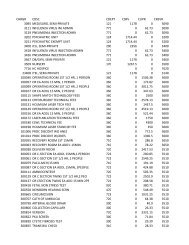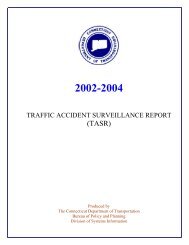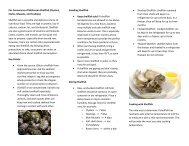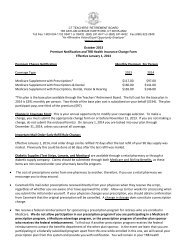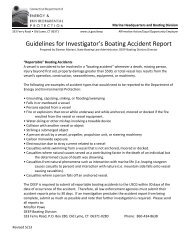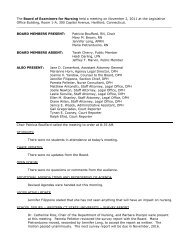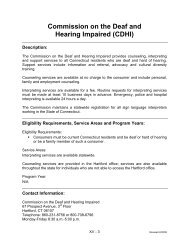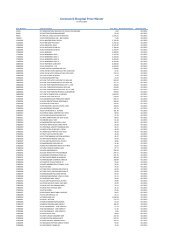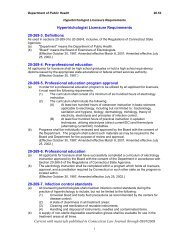Public Act 490 Guide - CT.gov
Public Act 490 Guide - CT.gov
Public Act 490 Guide - CT.gov
You also want an ePaper? Increase the reach of your titles
YUMPU automatically turns print PDFs into web optimized ePapers that Google loves.
SE<strong>CT</strong>ION 5: FARMLAND CLASSIFICATION<br />
The question that is frequently asked, and one that<br />
should be addressed and resolved early in the application<br />
process is, “What is farming?” Because agriculture in<br />
Connecticut is such a diverse and changing industry, it is<br />
important to refer to the state definition of agriculture,<br />
Connecticut General Statute 1-1q, in determining whether<br />
land qualifies as farmland:<br />
Except as otherwise specifically defined, the words<br />
“agriculture” and “farming” shall include cultivation of the<br />
soil, dairying, forestry, raising or harvesting any agricultural or<br />
horticultural commodity, including the raising, shearing, feeding,<br />
caring for, training and management of livestock, including<br />
horses, bees, poultry, fur-bearing animals and wildlife, and<br />
the raising or harvesting of oysters, clams, mussels, other<br />
molluscan shellfish or fish; the operation, management,<br />
conservation, improvement or maintenance of a farm and its<br />
buildings, tools and equipment, or salvaging timber or cleared<br />
land of brush or other debris left by a storm, as an incident to<br />
such farming operations: the production or harvesting of<br />
maple syrup or maple sugar, or any agricultural commodity,<br />
including lumber, as an incident to ordinary farming operations<br />
or the harvesting of mushrooms, the hatching of poultry,<br />
or the construction, operation or maintenance of ditches,<br />
canals, reservoirs or waterways used exclusively for farming<br />
purposes; handling, planting, drying, packing, packaging,<br />
processing, freezing, grading, storing or delivering to storage<br />
or to market, or to a carrier for transportation to market, or for<br />
direct sale any agricultural or horticultural commodity as an<br />
incident to ordinary farming operations, or, in the case of fruits<br />
and vegetables, as an incident to the preparation of such<br />
fruits or vegetables for market or for direct sale. The term “farm”<br />
includes farm buildings, and accessory buildings thereto,<br />
nurseries, orchards, ranges, greenhouses, hoophouses and<br />
other temporary structures or other structures used primarily<br />
for the raising and, as an incident to ordinary farming operations,<br />
the sale of agricultural or horticultural commodities.<br />
The term “aquaculture” means the farming of the waters of the<br />
state and tidal wetlands and the production of protein food,<br />
including fish, oysters, clams, mussels, and other molluscan<br />
shellfish, on leased, franchised and public underwater farmlands.<br />
Nothing herein shall restrict the power of a local zoning<br />
authority under Chapter 124.<br />
In 2005, PA 05-160 “An <strong>Act</strong> Concerning the<br />
Definition of Agricultural Operations” was passed.<br />
This legislation allows the Connecticut Department<br />
of Agriculture to provide an advisory opinion as to<br />
what constitutes agriculture or farming, pursuant to<br />
subsection (q) of §1-1 and regarding the classification<br />
of land as farmland or open space pursuant to<br />
§12-107b to §12-107f, inclusive. The Department of<br />
Agriculture may provide such an advisory opinion at<br />
the request of a municipality, state agency, assessor<br />
or landowner.<br />
THE FARM UNIT<br />
CGS 12-107b defines the term “farmland” as any tract<br />
or tracts of land, including woodland and wasteland, constituting<br />
a farm unit. A farm unit is not defined, although the<br />
general interpretation is something functioning as a whole<br />
farming operation. CGS Section 12-107c provide that the<br />
local assessor shall determine farmland for PA <strong>490</strong> purposes.<br />
The PA <strong>490</strong> statute does not define agriculture, however,<br />
agriculture as defined in CGS Section 1-1(q) is synonymous<br />
with farmland. This definition has been challenged in the<br />
courts and the courts have sided with the definition when<br />
used for PA <strong>490</strong>.<br />
• Holloway Bros., Inc. v Town of Avon (1965)<br />
• Johnson v. Board of Tax Review of the Town of Fairfield (1970)<br />
Although woodland and wasteland could easily be<br />
considered as non-productive to the farm operation,<br />
the inclusion of these lands recognized that the vast<br />
majority of Connecticut farms contain wetlands,<br />
hedgerows, outcrops, stony pastures, and woodlands<br />
as part of the landholding. Woodland and wetlands<br />
contribute to environmental quality. The intent of<br />
the legislation would not have been served by taxing<br />
natural and unused areas within the farm at a<br />
higher tax rate.<br />
FA<strong>CT</strong>ORS TO CONSIDER IN PA <strong>490</strong><br />
FARMLAND CLASSIFICATION<br />
Often it may be necessary for an assessor to perform on<br />
site visits. The assessor is directed to make the determination<br />
if land is farmland by taking several items into account as<br />
stated in CGS Section 12-107c:<br />
In determining whether such land is farmland, such<br />
assessor shall take into account, among other things, the<br />
acreage of such land, the portion thereof in actual use for<br />
farming or agricultural operations, the productivity of such<br />
land, the gross income derived therefrom, the nature and value<br />
of the equipment used in connection therewith, and the extent<br />
to which the tracts comprising such land are contiguous.<br />
Agriculture has changed a great deal over the past<br />
forty plus years since PA <strong>490</strong> was enacted. While the basic<br />
tenets of the act remain unchanged, fortunately the<br />
definition of agriculture is more fluid and has been<br />
amended from time to time to reflect the changing face<br />
of Connecticut agriculture.<br />
These factors should be taken into consideration when<br />
determining farmland status, but no single factor should be<br />
used as either confirmation or rejection for an application.<br />
Assessors should look at all these factors and others as a<br />
whole in determining PA <strong>490</strong> farmland classification and<br />
with consideration for the intent and purpose of PA <strong>490</strong>.<br />
10<br />
<strong>Public</strong> <strong>Act</strong> <strong>490</strong>: A Practical <strong>Guide</strong> and Overview • http://www.cfba.org/pa<strong>490</strong>guide.htm • Connecticut Farm Bureau Association




